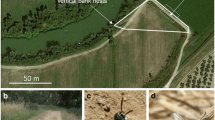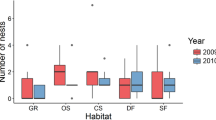Abstract
Studying temporal and spatial changes of aggregations of digger wasps through nesting seasons is interesting because of its link to social evolution via a semi-social pathway, but information about this topic is scarce. An aggregation of Cerceris arenaria Latreille was studied during 1997–1999 and for a short period in 2001. The colony grew in area and number of nests through the first three seasons, but the aggregation reduced in 2001, and this decrease was confirmed by a count of nests made in 2003 and 2005. The positions of the nest entrances remained almost constant over the years, at least in high-nest-density areas, because of the repeated use of the same burrows from which they emerged. This fact permits the population to exploit for many years a restricted area and could act as a nest-density-regulation method for fossorial species that rarely dig new nests, preventing an excessive nest density. The newly emerged females did not dig new nests, showed a high philopatry in the choice of their first nest, and preferred to look for other nests to occupy close to the ones recently abandoned (mainly for an undergone usurpation by a conspecific female). Philopatry, along with lack of new nest digging and position-dependent nest choice, is probably an important factor maintaining spatial stability of the aggregation through the years and could represent a first step in the evolution of a higher sociality in apoid burrowing Hymenoptera.




Similar content being viewed by others
References
Alcock J (1974) The nesting behaviour of Cerceris simplex macrosticta (Hymenoptera: Sphecidae). J Nat Hist 8:645–652
Alcock J (1975) Social interactions in the solitary wasp Cerceris simplex (Hymenoptera: Sphecidae). Behaviour 54:142–152
Alexander RD (1974) The evolution of social behavior. Annu Rev Ecol Syst 5:325–383
Alexander BA, Asís JD (1997) Patterns of nest occupancy and provisioning in Cerceris rufopicta Smith (Hymenoptera: Sphecidae). J Insect Behav 10:871–893
Brockmann HJ (1979) Nest-site selection in the great golden digger wasp, Sphex ichneumoneus L (Sphecidae). Ecol Entomol 4:211–224
Brockmann HJ, Dawkins R (1979) Joint nesting in a digger wasp as an evolutionarily stable pre-adaptation to social life. Behaviour 71:203–245
Byers GW (1978) Nests, prey, behaviour and development of Cerceris halone (Hymenoptera: Sphecidae). J Kansas Entomol Soc 51:818–831
Casiraghi M, Martinoli A, Bosco T, Preatoni D, Andrietti F (2001) Nest provisioning and stinging pattern in Ammophila sabulosa (Hymenoptera: Sphecidae): influence of prey size. Ital J Zool 68:299–303
Charlesworth D, Charlesworth B (1987) Inbreeding depression and its evolutionary consequences. Annu Rev Ecol Syst 18:237–268
Clark PJ, Evans FC (1954) Distance to the nearest neighbour as a measure of spatial relationships in populations. Ecology 35:445–453
Curio E (1978) The adaptive significance of avian mobbing I Teleonomic hypothesis and predictions. Z Tierpsychol 48:175–183
Elliot NB, Elliot WM (1987) Nest usurpation by females of Cerceris cribrosa (Hymenoptera: Sphecidae). J Kansas Entomol Soc 60:397–402
Elliot NB, Elliot WM, Salbert P (1981) Nesting behaviour of Cerceris zonata (Hymenoptera: Philanthidae). Ann Entomol Soc Am 74:127–129
Elliot NB, Shlotzhauer T, Elliot WM (1986) Nest use by females of the pre-social wasp Cerceris watlingensis (Hymenoptera: Sphecidae). Ann Entomol Soc Am 79:994–998
ESRI–Environmental system research institute Inc. (1999) PC ARC/INFO User Guides. Environmental System Research Institute Inc, Redlands, CA
Evans HE (1966) The comparative ethology and evolution of the sand wasps. Harvard University Press, Cambridge
Evans HE (1971) Observations on nesting behaviour of wasps of the tribe Cercerini (Hymenoptera: Sphecidae). J Kansas Entomol Soc 44:500–523
Evans HE (2000) Observations on the biology of Cerceris mimica Cresson (Hymenoptera: Sphecidae: Philanthinae). J Kansas Entomol Soc 73:220–224
Evans HE, Hook AW (1986) Nesting behaviour of Cerceris digger wasps, with special reference to nest reutilization and nest sharing (Hymenoptera: Sphecidae). Sociobiology 11:275–302
Evans HE, Matthews RW, Alcock J, Fritz MA (1976) Notes on the nests and prey of two subspecies of Cerceris rufimana Taschemberg (Hymenoptera: Sphecidae: Cercerini). J Kansas Entomol Soc 49:126–132
Field J, Foster WA (1995) Nest occupation in the digger wasp Cerceris arenaria: cooperation or usurpation?. Anim Behav 50:99–112
Field J, Shreeves G, Sumner S, Casiraghi M (2000) Insurance-based advantage to helpers in a tropical hover wasp. Nature (London) 404:869–871
Genaro JA, Sanchez CS (1993) Conducta de nidificacion de Cerceris cerverae, C Cubensis y C Festiva en Cuba (Hymenoptera: Sphecidae). Caribb J Sci 29:39–43
Grandi G (1961) Studi di un Entomologo sugli Imenotteri superiori. Boll Ist Entomol Univ Bologna 25:i–xv, 1–659
Greenwood PJ (1980) Mating systems, philopatry and dispersal in birds and mammals. Anim Behav 28:1140–1162
Greenwood PJ (1987) Inbreeding, philopatry and optimal outbreeding in birds. In: Cooke F, Buckley PA (eds) Avian genetics. Academic Press, London, pp 207–222
Hamilton WD (1971) Geometry for the selfish herd. J Theor Biol 31:295–311
Hook A (1987) Nesting behaviour of Texas Cerceris digger wasps with enphasis on nest reutilization and nest sharing (Hymenoptera: Sphecidae). Sociobiology 13:93–118
Klahn JE (1979) Philopatric and non-philopatric foundress associations in the social wasp Polistes fuscatus. Behav Ecol Sociobiol 5:417–424
Krause J, Ruxton GD (2002) Living in Groups. Oxford University Press, Oxford
Krebs JR, Davies NB (1987) An introduction to behavioural ecology. Blackwell Scientific Publications, Oxford
Krombein KV (1938) Further observations on the nesting habits of Cerceris nigriscens Smith (Hymenoptera: Sphecidae). Entomol News 49:1–3
Krombein KV (1963) Biological notes on Cerceris blakei Cresson (Hymenoptera: Sphecidae). Bull Brooklyn Entomol Soc 58:72–79
Kukuk PF, Decelles PC (1986) Behavioural evidence for population structure in Lasioglossum (Dialictus) zephyrum female dispersion patterns. Behav Ecol Sociobiol 19:233–239
Lin N, Michener CD (1972) Evolution of society in insects. Q Rev Biol 47:131–159
Linsley EG, MacSwain JW (1956) Some observations on the nesting habits and prey of Cerceris californica Cresson (Hymenoptera: Sphecidae). Ann Entomol Soc Am 49:71–84
Maynard-Smith J (1964) Group selection and kin selection. Nature 211:1145–1447
McCorquodale DB (1989) Nest sharing, nest switching, longevity and overlap of generations in Cerceris antipodes (Hymenoptera: Sphecidae). Insect Sociaux Paris 36:42–50
Michener CD (1974) The social behaviour of the bees: A comparative study. Harvard University Press, Cambridge MA, p 404
Michener CD, Lange RB, Bigarella JJ, Salamuni R (1958) Factors influencing the distribution of bees’ nests in earth banks. Ecology 39:207–217
Mueller UG, Warneke AF, Grafe UT, Ode PR (1979) Females size and nest defense in the digger wasp Cerceris fumipennis (Hymenoptera: Sphecidae: Philanthinae). J Theor Biol 77:473–496
Polidori C, Boesi R, Isola F, Andrietti F (2005) Provisioning patterns and choice of prey in the digger wasp cerceris arenaria (Hymenoptera: Crabronidae): the role of prey size. Eur J Entomol 102:801–804
Pusey AE (1987) Sex-biased dispersal and inbreeding avoidance in birds and mammals. Trends Ecol Evol 2:295–299
Rockwell RF, Barrowclough GF (1987) Gene flow and the genetic structure of populations. In: Cooke F, Buckley PA (eds) Avian genetics, a population and ecological approach. Academic Press, London, pp 223–255
Rosenheim JA (1988) Parasite presence acts as a proximate cue in the nest-site selection process of the solitary digger wasp, Ammophila dysmica (Hymenoptera: Sphecidae). J Insect Behav 1:333–342
Rosenheim JA (1990) Density-dependent parasitism and evolution of aggregated nesting in the solitary Hymenoptera. Ann Entomol Soc Am 83:277–286
Rubink WL (1978) The use of edaphic factors as cues for the nest-site selection by sand wasps (Hymenoptera: Sphecidae). PhD Dissertation, Colorado State University, Fort Collins
Salbert P, Elliot N (1979) Observation on the nesting behaviour of Cerceris watlingensis (Hymenoptera: Sphecidae, Philanthinae). Ann Entomol Soc Am 72:591–595
Shields WM (1982) Philopatry, inbreeding, and the evolution of sex. State University of New York, Albany
Shields WM (1987) Dispersal and mating systems: investigating their causal connections. In: Chepko-Sade BD, Halpin ZT (eds) Mammalian dispersal patterns: the effects of social structure on population genetics. University of Chicago Press, Chicago, pp 3–24
Tsuneki K (1965) The biology of East-Asiatic Cerceris (Hymenoptera: Sphecidae) with special reference to the peculiar social relationships and return to the nest in Cerceris hortivaga Kohl. Etizenia 9:1–46
Wade MJ, Breden F (1981) The effect of inbreeding on the evolution of altruistic behaviour by kin selection. Evolution 35:844–858
Wcislo WT (1984) Gregarious nesting of a digger wasp as a “selfish herd” response to a parasitic fly (Hymenoptera: Sphecidae; Diptera: Sarcophagidae). Behav Ecol Sociobiol 15:157–160
Weatherhead PJ, Forbes RL (1994) Natal philopatry in passerine birds: genetic or ecological influences? Behav Ecol 5:426–433
West-Eberhard MJ (1978) Polygyny and the evolution of social behaviour in wasps. J Kansas Entomol Soc 51:832–856
Willmer PG (1985a) Size effects on hygrothermal balance and foraging patterns of a sphecid wasp, Cerceris arenaria. Ecol Entomol 10:469–479
Willmer PG (1985b) Thermal ecology, size effects, and the origins of communal behaviour in Cerceris wasps. Behav Ecol Sociobiol 17:151–160
Yanega D (1990) Philopatry and nest founding in a primitively social bee, Halictus rubicundus. Behav Ecol Sociobiol 27:37–42
Acknowledgements
Thanks are due to Guido Pacchetti (University of Milan) for the help he gave in statistical analysis, Francesco Isola, Stefania Bevacqua, and Cristina Papadia for their help in collecting data, and Antonio Bianchi for the logistic support and the kind hospitality on his farm during the field work. Thanks are due to R. Henry and L. Disney (University of Cambridge) for reading and correction of the text. Part of the work was supported by a 3-year grant FIRB (Fondo per gli Investimenti della Ricerca di Base) RBAU019H94-001 (2001).
Author information
Authors and Affiliations
Corresponding author
About this article
Cite this article
Polidori, C., Casiraghi, M., Lorenzo, M.D. et al. Philopatry, nest choice, and aggregation temporal–spatial change in the digger wasp Cerceris arenaria (Hymenoptera: Crabronidae). J Ethol 24, 155–163 (2006). https://doi.org/10.1007/s10164-005-0176-0
Received:
Accepted:
Published:
Issue Date:
DOI: https://doi.org/10.1007/s10164-005-0176-0




